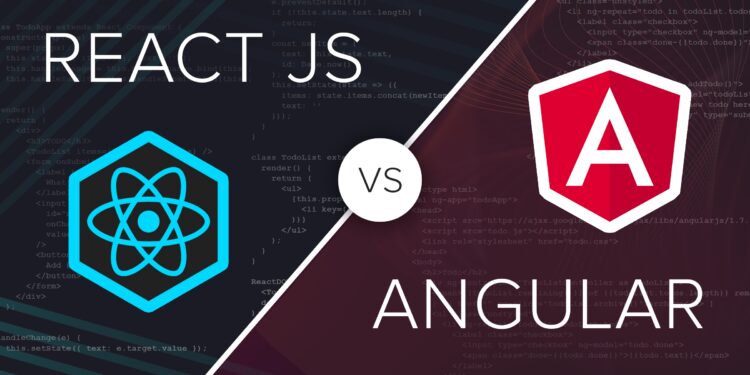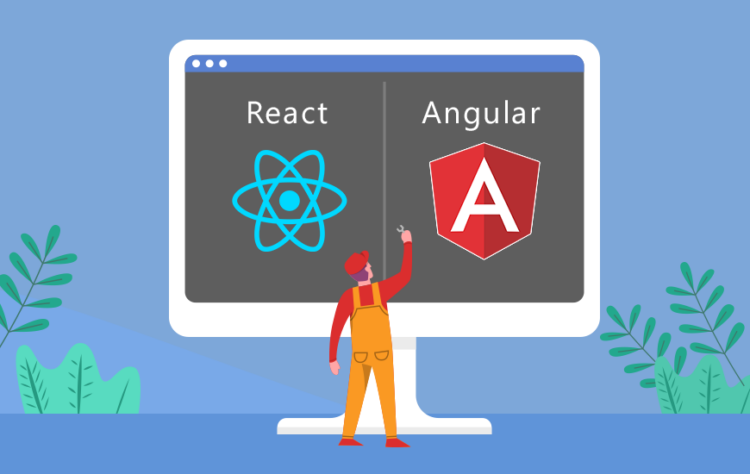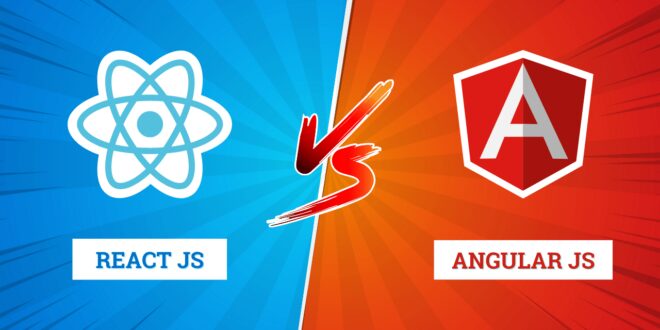For software engineers, libraries and frameworks are vital resources. They help with the development process by taking over some of the developer’s duties. The most widely used JavaScript frameworks for front-end apps nowadays are Angular and React.js.
How Does Angular Work Exactly?
The first version of Angular was released by Google in 2010 as AngularJS, an open-source JavaScript framework for creating single-page applications. It came with a set of parts and the MVC and MVVM frameworks needed to create the user interfaces for these applications.
On the other hand, the Angular team released Angular version 2.0 in 2016 after fully redesigning AngularJS. (Or Angular alone). The framework is open source as well, however, TypeScript serves as its core. With all the updates, Angular’s goal is to build scalable, dynamic web apps, which suggests more commercial possibilities for both small and large organizations.
Angular is a well-organized framework that lets you create apps using directives and components. To ensure that JavaScript code is suitable for all browsers, including Firefox, Chrome, Safari, Edge, iOS, and Android, recent versions of Angular load polyfill scripts automatically. Using the rich library and tooling provided by the framework, developers may create enterprise-level applications.
How Does React Function and What Is It?
React (also known as ReactJS) is a JavaScript framework for building user interfaces for Internet and mobile applications. In 2013, the initial library was published. In April 2022, React version 18 was published. Additionally, in 2015, the React Native framework for building native mobile apps was introduced.
All ReactJS (formerly Facebook) technologies have been released by and are supported by Meta. Since they are open source, they gain from the efforts of a global community of enthusiasts.
All platforms may benefit from the rapid, interesting, and scalable apps created with React.js front-end development.
Features of React and Angular

The two most well-liked frontend frameworks among programmers and business owners are React.js and Angular (although React is technically a library and occasionally referred to as a framework). Let’s examine the features of both technologies that contribute to their usefulness and allure.
Characteristics of Angular
The essential building blocks of software are called components. An Angular app is made up of different parts. Angular components are made up of TypeScript classes with decorators added on top of them. They help you specify the template, styles, selectors, and other Angular information that the framework makes use of.
The application is divided into three functional components using the Model-View-View-Model design pattern in Angular, which is also known as the MVVM architecture. This separation speeds up development and ensures software maintainability since one component may be easily changed without having an influence on the code of another.
Two-way data binding is a technique for keeping the model and the view’s data in sync. This suggests that if the model is changed, the change is immediately and instantly reflected in the view, and vice versa. The model and the view are constantly current thanks to this technique.
Each application function is handled by a separate object (service) in the dependency injection family of structural design patterns. An entity (benefit) (dependencies) may need other things. Dependencies are injected into the service at the time of creation.
The Angular Command Line Interface (CLI) is the official tool for setting up and interacting with Angular-based apps. You may avoid the hassle of complex settings and building tools like Webpack by using straightforward commands. Using CLI, end-to-end application testing is also feasible.
Declarative UI, which is quicker and easier, specifies the interface layout using HTML rather than JavaScript.
Characteristics of React

Faster and more memory-efficient code modifications are possible using virtual DOM, which is a virtual representation of real DOM elements. Any modifications to the code are supposed to initially appear in this virtual copy thanks to this virtualization. Then, rather than updating the whole UI project, the real DOM simply updates the code that has been updated.
Components are sections of pre-written code that already include their logic and controls. They may be reused inside a project, allowing for quick and easy development. They are used as building blocks in ReactJS projects. This is a special tool for projects with a broad reach.
The declarative paradigm requires just that you declare the desired results, or more specifically, the appearance of the application interface in its various stages. React will update the data as quickly as possible as it changes. A functional component is declared with a specific function, whereas a class-based component is declared with a specific class, therefore, distinct components are defined. Declarative views make debugging and coding more predictable.
A feature that enables data to be synced between the app state and the display is one-way data binding. One-way data binding is used to transfer data in a single path from parent to child components. Due to their encapsulation, properties cannot be accessed by other components. This feature provides greater code quality control because developers cannot directly alter component characteristics.
An HTML-like JavaScript syntax extension is called JSX. Developers can configure component rendering since they are accustomed to the syntax.
React Native is a framework that enables you to create native mobile apps utilizing native mobile components and make React code compatible with mobile platforms (Android and iOS). For React Native apps, end-to-end testing of in-app purchases is crucial for ensuring a seamless user experience. React Native developers can leverage frameworks and tools like Stormotion’s guide on end-to-end testing in-app purchases for React Native apps to streamline this process and deliver reliable in-app purchase functionality.
The Advantages of Angular and React

You must weigh the advantages and disadvantages of each tool before choosing a tech stack for your project. Let’s examine the key benefits of Angular and React.js.
Angular Advantages
Development for many platforms: Using NativeScript or Ionic, you can utilize Angular to build solutions for the web, desktop, and native mobile platforms.
App loading times may be longer owing to the complexity of modern JavaScript applications. You don’t have to give up efficiency or functionality while using Angular-based apps because of code separation. In order to load just the components needed by the application to render the user’s desired view, Component Router chunks the JavaScript code.
Built-in testing – The Jasmine and Karma testing frameworks are included by default with the Angular CLI. Basic unit tests are generated while building a component, and the results are shown on a webpage.
Productivity – To speed up the development process and assist developers in quickly building complex user experiences, Angular offers tools like templates and the CLI.
As a result of Google’s support for Angular, it has a sizable community, and you can always turn to experts and other fans for advice.
React Advantages
React-based apps run well due to the usage of a virtual DOM and the JSX syntax. App performance is important for many businesses, and ReactJS can outperform its rivals in this regard.
Short learning curve – Thanks to JSX and its components, the React framework is simple to comprehend and utilize. If you know the basics of JavaScript, learning React is easy.
Code reusability Reusing React.js components across a project may save time and increase the caliber of the final output.
Cross-platform development is made possible with React Native, allowing you to create code for internet solutions and reuse it for mobile apps. Additionally, a number of desktop and mobile browsers support React code.
Search engine bots can access material in HTML files and accurately index sites thanks to React.js’ server-side rendering. This suggests more clients and additional traffic for businesses.
There are millions of developers that work with React. To make sure that no coding issue is left unattended, you may ask for their help in groups and on specialized forums in messengers.
When Is It Better To Use Angular Or React?

In conclusion, there are certain parallels and differences between Angular and React. For one project, React.js could be the perfect fit, while Angular might not, and vice versa. Each project has unique technical, commercial, and financial requirements. As a consequence, you ought to make a choice depending on your needs.
Which Is Ultimately Superior?
It is difficult to declare either Angular or React.js to be better. These two reputable front-end development tools are well-known and effective in a variety of settings. As a result, the choice should always be based on the needs of a particular project.
SaM Solutions is a specialized software provider with a long history and many happy clients. Our web development specialists follow best practices to properly match consumer requirements.
Finally, both Angular and ReactJS are compact frameworks. Reacts is probably a little faster than Angular because it makes use of the virtual DOM. For professional guidance regarding which one to use, contact web design agency in Dubai team now.
 Hi Boox Popular Magazine 2024
Hi Boox Popular Magazine 2024



